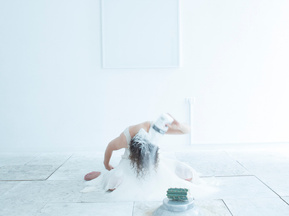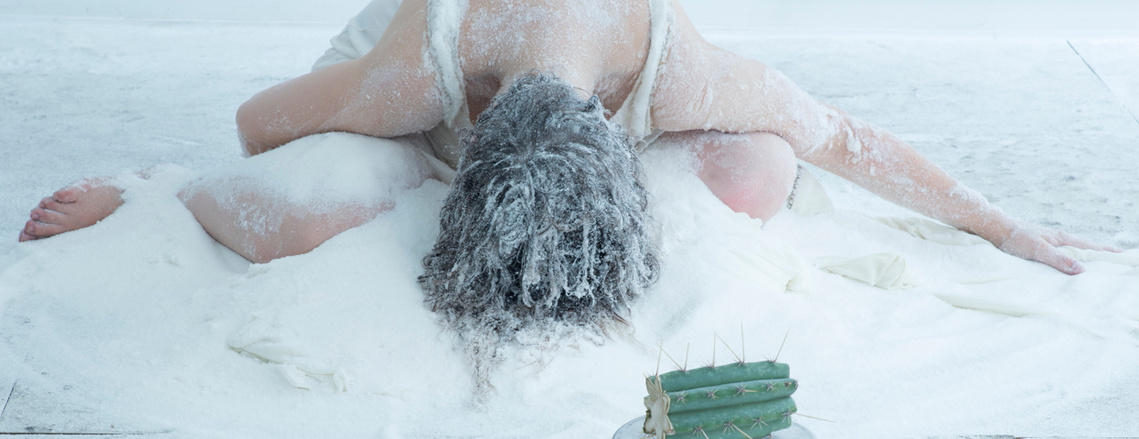Sugar Empire Fine Art Photography Project - Essay by curator Ruty Chinsky Amitay
In her video - performance work ‘Sugar Empire’, Ella Manor invades Yonatan Ullman’s Empire installation.
The installation, which was presented last spring in the space of Z I Z Art Space, Ullman coated the floor of the Gallery with sugar crystals. Protruding from the floor were tall and narrow containers in which there were a plethora of diverse liquids and objects: animal’s jaw bones swimming in cola; a wasp floating opposite its own reflection in a piece of broken glass; and other objects which are submerged and floating in gallons of mouthwash, colored sugar solutions and more. In the autonomous area that was created life and death were intermingled, nature and culture, preservation and decay, beauty and the horrific; the correlation with the history of art in general, and with Israeli art in particular.
Liberating sugar from its common use as a nutritional component which activates the sense of taste, and transforming the grains of sugar into a surface upon which to walk, has provided a new sensory experience. The crystalline particles crackle audibly under the footsteps of the visitors, so it is not easy to escape their presence. The profusion with which they are spread into the new reality created the focus of attention on the white matter, and released a flood of questions relating to the total control of sugar in the real and the capitalist world, as well as the allegorical context of the sugar relative to social and cultural structures(1) .
1. The association between sugar and capitalism, and social structures, also appears in things that Sigalit Landau said in an interview with Dalia Karpel, regarding the ‘Sugar Machine’ installation (2001) . Landau says in the interview that the inspiration for the work - in which sugar is also an allegory for capitalism - was "Sweet Movie" (1974) by Dušan Makavejev. Dalia Karpel, ‘Madness has its reasons’, HaAretz, 28/8/2002.
Manor penetrates into this "out of body domain". With her body covered in thin, light cotton she appears to be hatching from the sugary floor in front of one of the objects in Ullman’s installation.
This is a low, round base made of aluminum, which appears to be a kind of small altar on which the stump of a prickly cactus, cut width-wise, was placed horizontally. Opposite this array Manor performs a sequence of ceremonial activities with sugar; simultaneously she massages her body with the white granules and "washes" her hair with them, wallowing and burying her head in a mound of sugar as it sticks to her skin and her hair, and becomes a sort of sticky protective layer of white which is reminiscent of Vanitas. Waterfalls of sugar flow from her eyes as she wipes them away time after time. Very slowly the hem of her wedding dress, laying in a mound of sugar, becomes exposed, as does her body; its exposure echoing the iconic figure of the Goddess of Fertility, which is now dripping sugar.
Her posture and the movements of her body are round and soft, giving herself over wholly to the rough touch of the sugar crystals on her skin. The presence of cactus, so green and beautiful, seems like a prickly offering with its thorns unsheathed, constituting a constant threat to the events taking place in the Gallery. The metonymy of the cactus to barbed wire and a crown of thorns; the multiplicity of their associations with demarcation, borders, injury, suffering and victimization, as well as their incarnations in the history of Art, intensifying even more the appearance of the cross section, which revealed its inner parts and accentuated its round and jagged shape (2)
The alluring purist and sensual sequence of ritual activities which takes place in the territory that Manor entered and turned - if only for a limited time - into her own kingdom, is connected with the characteristics of the rite of passage formulated by anthropologist Arnold van Gennep, who found that the ritual process is composed of a three-part movement: separation, transition, and incorporation. Or, alternatively: the pre-liminal phase, the liminal and the post-liminal . The liminal (3) phase, which is the most significant of the three, is defined as the intermediate period of going to the area of the threshold, which is “in between” . The ceremony that Manor conducts has (4) intuitively come into existence "during", in a space that has liminal characteristics: ex-territorial and bordering on fantasy, but which is not completely disconnected from the external reality.
Scattered among it are threshold materials moving along the continuum between Life and Death, between creation and non-existence. Some of them have a violent reverberation such as the cactus, which was mentioned; and the blade of a knife which has been stabbed into a slice of red watermelon inside one the tanks that are scattered around the space. Removing normal everyday clothing and replacing it with minimal clothing is one of the characteristics of the rite of passage during the liminal phase . Thus it is possible to relate to the transparent and clinging nightgown which replaces (5) Manor’s everyday clothing outside of the arena that takes place in the Gallery.
2. Here too there is an intuitive connection with Sigalit Landau's performance video, Hula Hoop with Barbed Wire, (2000)
3. Victor Turner, from English: Noam Rachmilevitch, The Ritual Process: Structure and Anti-Structure, Resling, Tel Aviv, 2009, p 209
4. ibid. p 126
5. ibid. p 127
Despite the collection of Sisyphean symbols and the ritual nature of the performance, Manor is careful to avoid creating an integral and decipherable narrative in her work. In his book ‘The Ritual Process’ , Victor Turner refers to the scene where the ritual takes place as an ‘arena’ in which"conflicting processes compete ". This process, he writes, motivates dimensions of creativity, liberty, and opens the possibilities for reorganization of the system of social relationships and statuses. The rite of passage acts as a fluid and creative process which is supposed to cope with the basic anarchistic nature of the human being . Thus we are able to comprehend Manor’s artistic process as the acceptance of the creative process that moves between contradictory processes; between spontaneous and intuitive behavior and the pattern of organization and order; between the inner strength that wishes to remove the control barriers and the consciousness which inhibits it, and between everyday and reality.
Psychoanalyst Donald Winnicott also enquires about the significance of motivation that exists between various conditions and different forms of consciousness. In his discussions dealing with the question of the nature of life experience, he speaks of the intermediate space, which he calls "potential space".
This is an area of the third domain of the psyche which lies between being and living. In other words, the place where we live our lives, which is not our inner world: the raw material of which is the mental representation of the impulse in its form as unconscious fantasy; and it is also not the realistic world where our relationship moves between internalizing the inner representations and imposing our projections on it. When we experience our lives, says Winnicott, it is only when we are in the transition area, the intermediate area of personal experience (6).
6. Raanan Kulka, in: D. W. Winnicott, Playing and Reality, Am Oved, Tel Aviv, 2014 (1971), p 23.
Recognition that the work becomes realized in the existential experience that occurs in the potential space appeared in the writings of the Polish artist Alina Szapocznikow, although she does not use that term. She writes as follows: "The other day, Saturday, tired from having spent hours polishing my Rolls Royce in pink Portuguese marble, I sat in the sun and day- dreamed as I mechanically chewed a bit of gum. I shaping with my mouth odd- looking and bizarre forms' I suddenly realized what an extraordinary collection of abstract sculptures was moving between my teeth. One has only to photograph and enlarge my masticated creations in order to achieve a sculptural presence. Chew well then. Look around you/ Creation lies just between dreams and daily work." (7)
Incidental discovery, which she writes of, identifies the daily experience as swinging between dream and reality, as a space where the emerging work of art seeks to capture the elusive occurrence in a morphological manner, takes place in Manor’s creation.
7. Esther Dothan, work here or: Alina Szapocznikow of chewing gum, in: Alina Szapocznikow / Body Trace (curator: lover of Israel), Tel Aviv Museum of Art, 2014, p 20.
Manor feels considerable identity with Szapocznikow’s work, whose retrospective exhibition was presented this year at Tel Aviv Museum of Art and which the artist visited; particularly in the connection that exists between the Sugar Empire and the chewing-gum works of the great artist which were realized during physical activity . 8
Together with Manor in her apparently innocent intervention in the Ullman installation, Szapocznikow’s inspiration also intruded and, with her - as invisible guests - also the chewing-gum sculptures which removed the candy from its original context and placed it in the field of Art. Therefore, Ullmann’s hidden presence also hovers above "Sugar Empire", and casts in it yet another layer of reference, which has been created by Manor’s act of intervention.
Ruty Chinsky-Amitay
8 Conversation with the artist on Alina Szapocznikow dated 06/19/14












